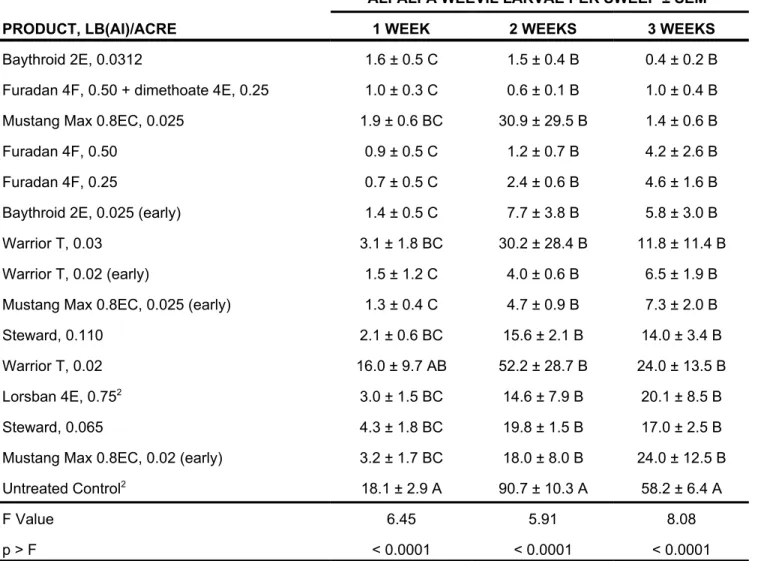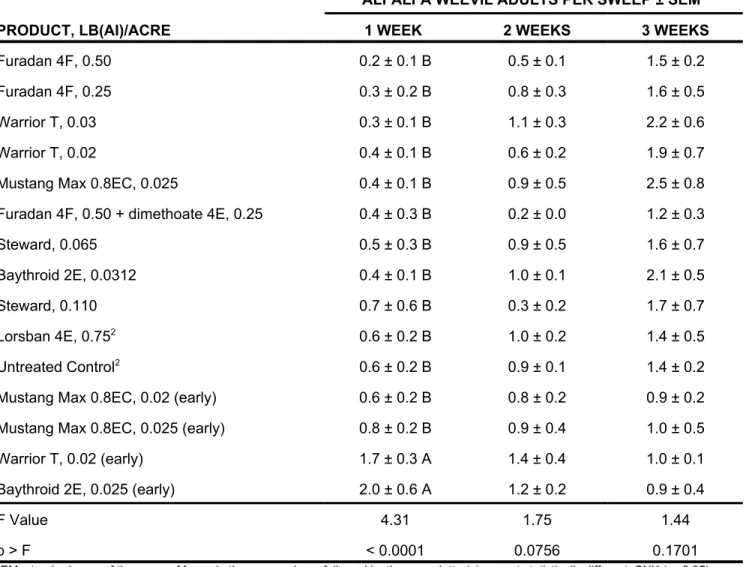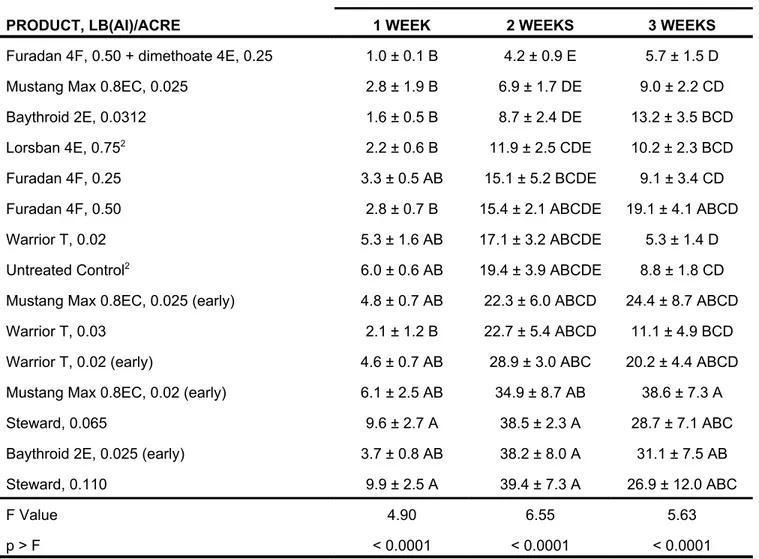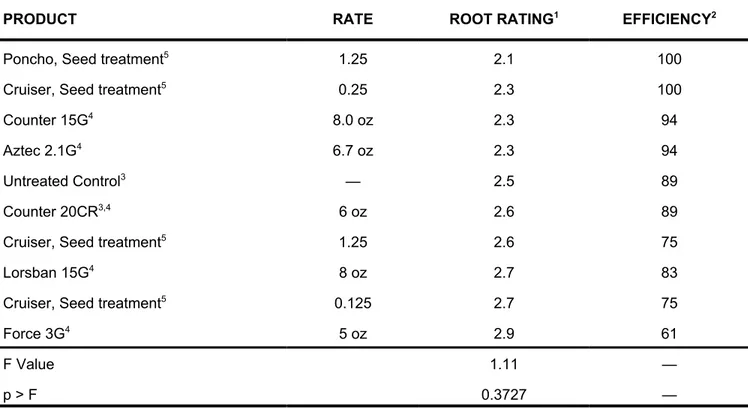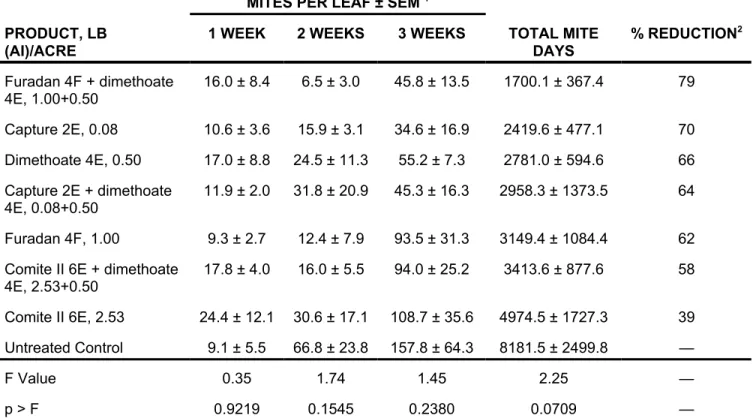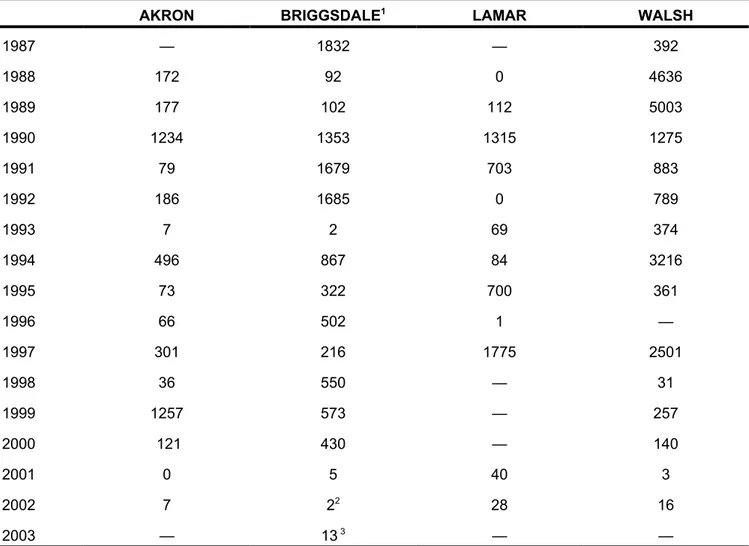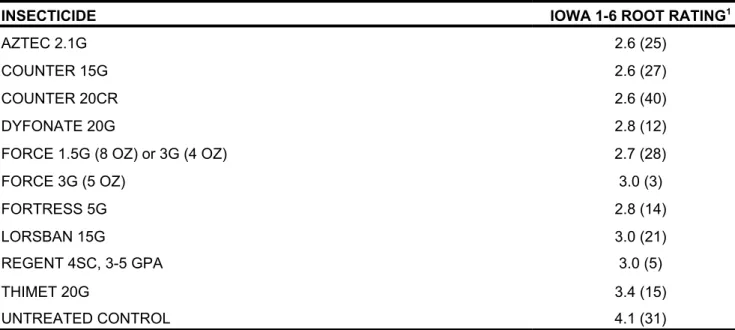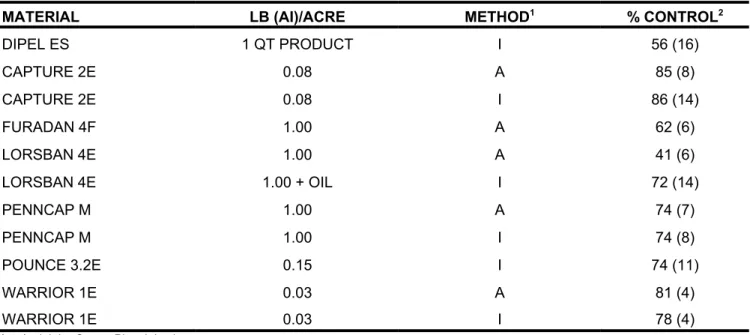2003 Colorado Field Crop
Insect Management Research
and Demonstration Trials
Shawn M. Walter
Frank B. Peairs
Assefa Gebre-Amlak
TABLE OF CONTENTS
Control of Russian wheat aphid in winter wheat with hand-applied insecticides, ARDEC, Fort Collins, CO, 2003 1 Control of Russian wheat aphid in winter wheat with Cruiser seed treatments, ARDEC, Fort Collins, CO, 2003 . 3 Control of Russian wheat aphid in spring barley with seed treatments and hand-applied insecticides, ARDEC, Fort
Collins, CO, 2003 . . . 5
Control of alfalfa insects in alfalfa with hand-applied insecticides, ARDEC, Fort Collins, CO, 2003 . . . 7
Control of western corn rootworm in corn, ARDEC, Fort Collins, CO, 2003 . . . 11
Control of Banks grass mite in corn with hand-applied insecticides, ARDEC, Fort Collins, CO, 2003 . . . 13
The 2003 Golden Plains Pest Survey Program . . . 15
2003 Light Trap Operators . . . 15
2003 Pest Survey Committee . . . 15
Contributors to the 2003 Golden Plains Pest Survey Program . . . 16
Summary of 2003 light and suction trap catches . . . 17
Pheromone traps, ARDEC, 2002 . . . 27
Insecticide performance summaries . . . 31
Acknowledgments . . . 35
CONTROL OF RUSSIAN WHEAT APHID IN WINTER WHEAT WITH HAND-APPLIED INSECTICIDES, ARDEC, FORT COLLINS, CO, 2003
Shawn Walter, Jeff Rudolph, Terri Randolph, Silas Davidson, Aubrey Sloat, Jesse Stubbs, Mahesh Venkataraman, Frank Peairs, Department of Bioagricultural Sciences and Pest Management
CONTROL OF RUSSIAN WHEAT APHID IN WINTER WHEAT WITH HAND-APPLIED INSECTICIDES, ARDEC, FORT COLLINS, CO, 2003: Treatments were applied on 15 April 2003 with a 'rickshaw-type' CO2 powered sprayer calibrated to apply 20 gal/acre at 3 mph and 32 psi through three 8004 (LF4) nozzles mounted on a 5.0 ft boom. Conditions were slightly overcast with northwest winds of 4 mph and temperature 60°F at the time of treatment. Plots were 6 rows (5.0 ft) by 28.0 ft and were arranged in six replicates of a randomized, complete block design. Crop stage at application was late tillering (Zadoks 26-27). The crop had been infested with greenhouse-reared aphids on 10-11 March 2003.
Treatments were evaluated by collecting 20 symptomatic tillers along the middle four rows of each plot one, two and three weeks after treatment. Tiller samples were placed in Berlese funnels for 24 hours to extract aphids into alcohol for counting. Precounts averaged 4± 1 Russian wheat aphids per tiller. Aphid counts transformed by the square root + ½ method were used for analysis of variance and mean separation by the Student-Neuman-Keul test ("=0.05). Original means are presented in the tables. A test for outliers was run on the data for each week and 5 data points were removed from the analysis. Total insect days for each treatment were calculated according the method of Ruppel (Journal of Economic Entomology 76: 375-7, 1983). Reductions in insect days were
calculated by Abbott's (1925) formula: (percent reduction = ((untreated-treated)/untreated) X 100). Insect days were also compared by analysis of variance and the Student-Neuman-Keul test ("=0.05) with original means presented in the tables.
Aphid pressure was as not severe as in past artificially-infested winter wheat experiments, with about 9
aphids/tiller in the untreated control at 3 weeks post treatment. The wheat was healthy due to an abundance of moisture and cool temperatures in the spring. All treatments except F1785-03-01, 0.054 had fewer aphids than the untreated control at 1 week after treatment. All treatments had fewer aphid days than the untreated control at 2 and 3 weeks after treatment. All treatments except F1785-03-01, 0.054 and dimethoate 4E, 0.38 reduced total aphid days over three weeks by more than 90%, the level of performance observed by the more effective treatments in past experiments. No phytotoxicity was observed with any treatment.
Field History
Pest: Russian wheat aphid, Diuraphis noxia (Mordvilko) Cultivar: 'TAM 107'
Planting Date: 17 September 2002
Irrigation: Post planting, linear move sprinkler with drop nozzles Crop History: Fallow in 2002
Herbicide: None
Insecticide: None prior to experiment Fertilization: None
Soil Type: Sandy clay loam, OM 3.5%, pH 7.6
2003 FIELD CROP INSECT MANAGEMENT - 2
Table 1. Control of Russian wheat aphid in winter wheat, ARDEC, Fort Collins, CO, 2003. APHIDS PER TILLER ± SEM1
PRODUCT, LB (AI)/ACRE 1 WEEK 2 WEEKS 3 WEEKS TOTAL APHID
DAYS ± SEM1 REDUCTION% 2 XR-225 60g/l, 0.005 0.1 ± 0.0 B 0.1 ± 0.0 C 0.1 ± 0.1 D 24.3 ± 6.4 C 99 Di-Syston 8E, 0.75 0.1 ± 0.1 B 0.1 ± 0.1 C 0.1 ± 0.1 CD 34.0 ± 16.3 C 98 Lorsban 4E-SG, 0.25 0.4 ± 0.2 B 0.2 ± 0.2 C 0.1 ± 0.1 CD 63.2 ± 20.0 C 97 Lorsban 4E-SG, 0.50 0.5 ± 0.2 B 0.1 ± 0.1 C 0.4 ± 0.3 CD 67.2 ± 29.5 C 96 Warrior T, 0.03 0.8 ± 0.7 B 0.1 ± 0.0 C 0.2 ± 0.1 CD 73.0 ± 37.3 C 96 Lorsban 4E-SG, 0.38 0.2 ± 0.1 B 0.2 ± 0.1 C 0.6 ± 0.2 CD 74.7 ± 26.8 C 96 XR-225 60g/l, 0.015 0.3 ± 0.1 B 0.3 ± 0.1 C 0.6 ± 0.3 CD 99.8 ± 20.0 C 94 Warrior T, 0.01 0.3 ± 0.1 B 0.4 ± 0.2 C 0.3 ± 0.1 CD 102.3 ± 40.6 C 94 Capture 2E, 0.03 0.4 ± 0.1 B 0.2 ± 0.1 C 1.0 ± 0.8 CD 130.0 ± 58.1 C 93 Mustang Max 0.8EC,
0.025 0.8 ± 0.3 B 0.4 ± 0.1C 0.7 ± 0.4 CD 160.8 ± 49.1 C 91 Dimethoate 4E, 0.38 0.7 ± 0.3 B 0.6 ± 0.2 C 2.1 ± 0.5 BC 293.7 ± 65.9 C 84 F1785-03-01, 0.054 4.4 ± 1.5 A 3.0 ± 0.9 B 4.3 ± 1.9 B 1027.3 ± 292.5 B 43 Untreated Control 5.1 ± 1.4 A 5.5 ± 0.8 A 9.1 ± 0.6 A 1806.5 ± 185.4 A — F Value 8.95 20.46 15.60 26.86 — p > F < 0.0001 < 0.0001 < 0.0001 < 0.0001 — 1SEM, standard error of the mean. Means in the same column followed by the same letter(s) are not statistically different, SNK ("=0.05). 2Percent reduction in total aphid days, calculated by the Ruppel method.
CONTROL OF RUSSIAN WHEAT APHID IN WINTER WHEAT WITH CRUISER SEED TREATMENTS, ARDEC, FORT COLLINS, CO, 2003
Shawn Walter, Jeff Rudolph, Terri Randolph, Dan Natan, Aubrey Sloat, Jesse Stubbs, Mahesh Venkataraman, Frank Peairs, Department of Bioagricultural Sciences and Pest Management
CONTROL OF RUSSIAN WHEAT APHID IN WINTER WHEAT WITH CRUISER SEED TREATMENTS, ARDEC, FORT COLLINS, CO, 2003: Treatments were planted on 17 September 2002 with a 6 row test plot drill at a rate
of 60 lbs of seed/acre. Plots were 6 rows (5.0 ft) by 25.0 ft and were arranged in six replicates of a randomized, complete block design. The crop had been infested at the tillering (Zadoks 26-27) with greenhouse-reared aphids on 10-11 March 2003.
Treatments were evaluated by collecting 20 random tillers along the middle four rows of each plot 3 times at 2 week intervals. Tiller samples were placed in Berlese funnels for 24 hours to extract aphids into alcohol for counting. Aphid counts transformed by the square root + ½ method were used for analysis of variance and mean separation by the Student-Neuman-Keul test ("=0.05). Original means are presented in the tables. Total insect days for each treatment were calculated according the method of Ruppel (Journal of Economic Entomology 76: 375-7, 1983). Reductions in insect days were calculated by Abbott's (1925) formula: (percent reduction = ((untreated-treated)/untreated) X 100). Insect days were also compared by analysis of variance and the Student-Neuman-Keul test ("=0.05) with original means presented in the tables. Yields were taken on 16 July 2003 by hand harvesting 1m row. Plot yields were compared by analysis of variance and the
Student-Neuman-Keul test ("=0.05).
Aphid pressure was less severe than observed in past artificially-infested spring barley experiments, 6 aphids per tiller in the untreated control at the third sample date. The wheat was healthy due to an abundance of moisture and cool temperatures in the spring. Gaucho, 8.3 fl oz/100 lb seed had fewer aphids than the untreated control at the first and second sample date. Gaucho, 8.3 fl oz/100 lb seed had fewer aphid days than the untreated control. Gaucho, 8.3 fl oz/100 lb seed reduced total aphid days by more than 90% after the third sample date, the level of performance observed by the more effective treatments in past spring barley experiments. No treatment yielded more than the untreated control (Table 1). The Cruiser and Gaucho treated plots were infested when the plants were potentially toxic to the aphids and may not have received initial infestations comparable with other
treatments. No phytotoxicity was observed with any treatment.
Field History
Pest: Russian wheat aphid, Diuraphis noxia (Mordvilko)
Cultivar: TAM 107
Planting Date: 17 September 2002
Irrigation: Post planting, linear move sprinkler with drop nozzles
Crop History: Fallow in 2002, wheat in 2001
Insecticide: None prior to experiment
Fertilization: None
Soil Type: Sandy clay loam, OM 3.5%, pH 7.6
2003 FIELD CROP INSECT MANAGEMENT - 4
Table 1. Control of Russian wheat aphid in winter wheat
with Cruiser seed treatments,
ARDEC, Fort Collins, CO, 2003
APHIDS PER TILLER ± SEM
1 TREATMENT 1 st WEEK 3 rd WEEK 5 th WEEK
TOTAL APHID DAYS ± SEM
1 % REDUCTION 2 YIELD 3 Gaucho, 8.3fl oz/100 lb sd 0.2 ± 0.1 B 0.0 ± 0.0 C 1.1 ± 0.7 B 247.6 ± 132.5 B 91 144.7 Cruiser 5fs, 1.33 fl oz/100 lb sd 0.7 ± 0.2 AB 0.8 ± 0.4 BC 3.3 ± 0.6 AB 842.8 ± 125.6 AB 63 138.0
Dividend xtreme 0.96fs, 15.0GA/100kg sd + Cruiser 5fs, 5.0GA/100kg sd
0.6 ± 0.3 AB 0.6 ± 0.4 BC 3.6 ± 1.4 AB 906.2 ± 426.9 AB 65 140.6
Dividend xtreme 0.96fs, 15.0GA/100kg sd + Cruiser 5fs, 39.0GA/100kg sd
0.9 ± 0.3 AB 0.6 ± 0.2 BC 5.0 ± 1.5 AB 1226.4 ± 255.0 AB 54 126.5 Cruiser 5fs, 0.75 fl oz/100 lb sd 0.8 ± 0.2 AB 1.3 ± 0.3 ABC 9.8 ± 3.4 A 1509.0 ± 274.1 AB 12 124.9
Raxil-Thiram 1.77fs, 52.0GA/100kg sd + Gaucho480fs, 48.0GA/100kg sd
0.8 ± 0.2 AB 1.6 ± 0.7 ABC 6.0 ± 1.7 AB 1544.0 ± 407.8 AB 35 117.4
Dividend xtreme 0.96fs, 15.0GA/100k
g sd 1.3 ± 0.3 A 2.8 ± 0.9 AB 8.3 ± 1.7 A 2383.8 ± 574.8 A 2 123.2 Untreated Control 1.0 ± 0.2 AB 4.6 ± 1.6 A 5.8 ± 0.6 AB 2420.7 ± 524.9 A — 121.2
Dividend xtreme 0.96fs, 15.0GA/100kg sd + Cruiser 5fs, 7.5GA/100kg sd
1.1 ± 0.3 AB 3.2 ± 1.1 AB 8.4 ± 2.0 A 2464.0 ± 461.9 A -3 118.5 F Value 2.20 3.81 3.41 3.24 — 1.12 p > F 0.0476 0.0027 0.0044 0.0075 — 0.3692
1 SEM, standard error of the mean. Means in the same column follo
w
ed by
the same letter(s) are not significantly
different, SNK
(
"
=0.05).
2 Percent reduction in total aphid day
s, calculated by
the Ruppel method.
3 Y
ield presented in total seed w
CONTROL OF RUSSIAN WHEAT APHID IN SPRING BARLEY WITH SEED TREATMENTS AND HAND-APPLIED INSECTICIDES, ARDEC, FORT COLLINS, CO, 2003
Shawn Walter, Jeff Rudolph, Terri Randolph, Dan Natan, Aubrey Sloat, Jesse Stubbs, Mahesh Venkataraman, Frank Peairs, Department of Bioagricultural Sciences and Pest Management
CONTROL OF RUSSIAN WHEAT APHID IN SPRING BARLEY WITH SEED TREATMENTS AND
HAND-APPLIED INSECTICIDES, ARDEC, FORT COLLINS, CO, 2003: The foliar treatment was applied on16 May 2003 with a 'rickshaw-type' CO2 powered sprayer calibrated to apply 20 gal/acre at 3 mph and 30 psi through three 8004 (LF4) nozzles mounted on a 5.0 ft boom. Conditions were partly cloudy with winds from the northwest at less than 4 mph and a temperature of 65°F at the time of treatment. Crop stage at application date was tillering (Zadoks 26-27). Plots were 6 rows (5.0 ft) by 25.0 ft and were arranged in six replicates of a randomized,
complete block design. The crop had been infested at the 2 leaf stage (Zadoks 12) with greenhouse-reared aphids on 11 April 2003.
Treatments were evaluated by collecting 20 random tillers along the middle four rows of each plot three days prior and one, three and five weeks after the foliar treatment. Tiller samples were placed in Berlese funnels for 24 hours to extract aphids into alcohol for counting. Precounts in the untreated plots averaged 5 ± 1 Russian wheat aphids per tiller. Aphid counts transformed by the square root + ½ method were used for analysis of variance and mean separation by the Student-Neuman-Keul test ("=0.05). Original means are presented in the tables. Total insect days for each treatment were calculated according the method of Ruppel (Journal of Economic Entomology 76: 375-7, 1983). Reductions in insect days were calculated by Abbott's (1925) formula: (percent reduction = ((untreated-treated)/untreated) X 100). Insect days were also compared by analysis of variance and the
Student-Neuman-Keul test ("=0.05) with original means presented in the tables. Yields were taken on 1 August 2004 with a Hage 125 Harvester. Yields were converted to bushels per acre adjusted by subsample moisture to 12% moisture. Plot yields were compared by analysis of variance and the Student-Neuman-Keul test ("=0.05). Aphid pressure was as severe as observed in past artificially-infested spring barley experiments, 80 aphids/tiller in the untreated control at 3 weeks after treatment. All treatments had fewer aphids than the untreated control at one, two and three weeks after treatment. All treatments had fewer aphid days than the untreated control. All treatments reduced total aphid days by more than 90% after 3 weeks, the level of performance observed by the more effective treatments in past spring barley experiments (Table 1). All treatments yielded more than the untreated control (Table 1). The Cruiser and Gaucho treated plots were infested when the plants were potentially toxic to the aphids and may not have received initial infestations comparable with other treatments. No
phytotoxicity was observed with any treatment. Field History
Pest: Russian wheat aphid, Diuraphis noxia (Mordvilko) Cultivar: Moravian 37
Planting Date: 12 March 2003
Irrigation: Linear move sprinkler with drop nozzles Crop History: Corn in 2002
Herbicide: Bronate, 0.5 pt/acre, Harmony Extra, 0.3 oz/acre on 7 June 2002 Insecticide: None prior to experiment
Fertilization: None
Soil Type: Clay loam, OM 3.1%, pH 7.8
2003 FIELD CROP INSECT MANAGEMENT - 6
Table 1. Control of Russian wheat aphid in spring barley
, ARDEC, Fort Collins, CO, 2003.
APHIDS PER TILLER ± SEM
1 PRODUCT, LB(AI)/ACRE 1 WEEK 2 WEEKS 3 WEEKS T
OTAL APHID DAYS ±
SEM 1 % REDUCTION 2 YIELD 3 Gaucho, 8.3fl oz/100lb sd 0.1 ± 0.1 B 0.4 ± 0.2 B 0.6 ± 0.2 C 165.4 ± 31.4 B 99 86 A Cruiser, 1.33 fl oz/100 lb sd 0.3 ± 0.1 B 0.7 ± 0.2 B 1.2 ± 0.3 C 324.1 ± 59.4 B 99 77 AB Cruiser, 0.75 fl oz/100 lb sd 0.2 ± 0.0 B 1.9 ± 0.4 B 4.9 ± 1.9 BC 979.3 ± 263.5 B 97 77 AB Warrior T, 0.03 0.8 ± 0.2 B 3.2 ± 0.6 B 9.6 ± 3.0 B 1988.3 ± 452.7 B 94 73 B Untreated Control 14.8 ± 2.5 A 90.0 ± 34.5 A 80.2 ± 14.0 A 26932.7 ± 5079.2 A — 33 C F Value 69.29 15.32 56.03 27.50 — 51.82 p > F < 0.0001 < 0.0001 < 0.0001 < 0.0001 — < 0.0001
1 SEM, standard error of the mean. Means in the same column follo
w
ed by
the same letter(s) are not significantly
different, SNK
(
"
=0.05).
2 Percent reduction in total aphid day
s, calculated by
the Ruppel method.
3 Y
ield presented in bushels/acre
CONTROL OF ALFALFA INSECTS IN ALFALFA WITH HAND-APPLIED INSECTICIDES, ARDEC, FORT COLLINS, CO, 2003
Shawn Walter, Jeff Rudolph, Terri Randolph, Dan Natan, Aubrey Sloat, Jesse Stubbs, Mahesh Venkataraman, Frank Peairs, Department of Bioagricultural Sciences and Pest Management
CONTROL OF ALFALFA INSECTS IN ALFALFA WITH HAND-APPLIED INSECTICIDES, ARDEC, FORT COLLINS, CO, 2003: Early treatments were applied on15 April 2003 with a ‘rickshaw-type’ CO2 powered sprayer calibrated to apply 20 gal/acre at 3 mph and 30 psi through six 8004 (LF4) nozzles mounted on a 10.0 ft boom. All other treatments were applied in the same manner on 16 May 2003. Conditions were clear with northwest 4 mph winds and temperature of 60°F at the time of early treatments. Conditions were partly cloudy with winds from the northwest at less than 4 mph and a temperature of 65°F at the time of the late treatments. Plots were 10.0 ft by 25.0 ft and arranged in four replicates of a randomized, complete block design. Untreated control and Lorsban 4E plots were replicated eight times for a more accurate comparison of treatment effects on yield. Crop was breaking dormancy at the time of early treatments. Crop height at the time of late treatments was 1.0 ft.
Treatments were evaluated by taking 10, 180N sweeps per plot with a standard 15 inch diameter insect net one,
two and three weeks after late treatments. Precounts were taken one day prior to late treatments by taking 25,
180N sweeps per replication. Alfalfa weevil larvae, alfalfa weevil adults and pea aphids were counted. Precounts
averaged 13 ± 1 alfalfa weevil larvae per sweep. Insect counts transformed by the square root + ½ method were used for analysis of variance and mean separation by the Student-Neuman-Keul test ("=0.05). Original means are presented in the tables. Yields were taken in the Lorsban 4E, 0.75(AI)/acre and untreated control plots on 9 June 2003 with a Carter forage harvester. Yields were converted to tons per acre adjusted by subsample moisture. Treated plots were compared to the untreated control using a two-tailed t-test with assumed equal variance ("=0.05).
Alfalfa weevil and pea aphid pressure washigh. All treatments had fewer alfalfa weevil larvae than the untreated
control at one, two and three weeks after treatment. All treatments had fewer alfalfa weevil adults than the untreated control at one week after treatment. No treatment had fewer pea aphids than the untreated control at
one and two weeks after treatment. No phytotoxicity was observed with any treatment. The plots treated with
Lorsban 4E, 0.75(AI)/acre yielded 3.0 tons/acre, 13.2% more than the untreated plots which yielded 2.3 tons/acre.
The difference was not significant (two-tailed t-test, t=1.58, df=13, p(t>t0.05)=0.1371). Yield reduction measured
since 1995 has averaged 9.5%, with a range of 1.4% to 20.9%.
Field History
Pests: Alfalfa weevil, Hypera postica (Gyllenhal)
Pea aphid, Acyrthosiphon pisum (Harris)
Cultivar: Unknown
Plant Stand: Mostly uniform, weeds
Irrigation: Linear move sprinkler with drop nozzles
Crop History: Alfalfa in 2002
Herbicide: None
Insecticide: None prior to experiment
Fertilization: None
Soil Type: Sandy clay loam, OM 3.6%, pH 7.7
2003 FIELD CROP INSECT MANAGEMENT - 8
Table 1. Control of alfalfa weevil larvae, ARDEC, Fort Collins, CO, 2003.
ALFALFA WEEVIL LARVAE PER SWEEP ± SEM1
PRODUCT, LB(AI)/ACRE 1 WEEK 2 WEEKS 3 WEEKS
Baythroid 2E, 0.0312 1.6 ± 0.5 C 1.5 ± 0.4 B 0.4 ± 0.2 B
Furadan 4F, 0.50 + dimethoate 4E, 0.25 1.0 ± 0.3 C 0.6 ± 0.1 B 1.0 ± 0.4 B
Mustang Max 0.8EC, 0.025 1.9 ± 0.6 BC 30.9 ± 29.5 B 1.4 ± 0.6 B
Furadan 4F, 0.50 0.9 ± 0.5 C 1.2 ± 0.7 B 4.2 ± 2.6 B
Furadan 4F, 0.25 0.7 ± 0.5 C 2.4 ± 0.6 B 4.6 ± 1.6 B
Baythroid 2E, 0.025 (early) 1.4 ± 0.5 C 7.7 ± 3.8 B 5.8 ± 3.0 B
Warrior T, 0.03 3.1 ± 1.8 BC 30.2 ± 28.4 B 11.8 ± 11.4 B
Warrior T, 0.02 (early) 1.5 ± 1.2 C 4.0 ± 0.6 B 6.5 ± 1.9 B
Mustang Max 0.8EC, 0.025 (early) 1.3 ± 0.4 C 4.7 ± 0.9 B 7.3 ± 2.0 B
Steward, 0.110 2.1 ± 0.6 BC 15.6 ± 2.1 B 14.0 ± 3.4 B
Warrior T, 0.02 16.0 ± 9.7 AB 52.2 ± 28.7 B 24.0 ± 13.5 B
Lorsban 4E, 0.752 3.0 ± 1.5 BC 14.6 ± 7.9 B 20.1 ± 8.5 B
Steward, 0.065 4.3 ± 1.8 BC 19.8 ± 1.5 B 17.0 ± 2.5 B
Mustang Max 0.8EC, 0.02 (early) 3.2 ± 1.7 BC 18.0 ± 8.0 B 24.0 ± 12.5 B
Untreated Control2 18.1 ± 2.9 A 90.7 ± 10.3 A 58.2 ± 6.4 A
F Value 6.45 5.91 8.08
p > F < 0.0001 < 0.0001 < 0.0001
1SEM, standard error of the mean. Means in the same column followed by the same letter(s) are not statistically different, SNK ("=0.05) 2Treatment repeated (8 replicates rather than 4) for purposes of measuring yield.
Table 2. Control of alfalfa weevil adults, ARDEC, Fort Collins, CO, 2003.
ALFALFA WEEVIL ADULTS PER SWEEP ± SEM1
PRODUCT, LB(AI)/ACRE 1 WEEK 2 WEEKS 3 WEEKS
Furadan 4F, 0.50 0.2 ± 0.1 B 0.5 ± 0.1 1.5 ± 0.2
Furadan 4F, 0.25 0.3 ± 0.2 B 0.8 ± 0.3 1.6 ± 0.5
Warrior T, 0.03 0.3 ± 0.1 B 1.1 ± 0.3 2.2 ± 0.6
Warrior T, 0.02 0.4 ± 0.1 B 0.6 ± 0.2 1.9 ± 0.7
Mustang Max 0.8EC, 0.025 0.4 ± 0.1 B 0.9 ± 0.5 2.5 ± 0.8
Furadan 4F, 0.50 + dimethoate 4E, 0.25 0.4 ± 0.3 B 0.2 ± 0.0 1.2 ± 0.3
Steward, 0.065 0.5 ± 0.3 B 0.9 ± 0.5 1.6 ± 0.7
Baythroid 2E, 0.0312 0.4 ± 0.1 B 1.0 ± 0.1 2.1 ± 0.5
Steward, 0.110 0.7 ± 0.6 B 0.3 ± 0.2 1.7 ± 0.7
Lorsban 4E, 0.752 0.6 ± 0.2 B 1.0 ± 0.2 1.4 ± 0.5
Untreated Control2 0.6 ± 0.2 B 0.9 ± 0.1 1.4 ± 0.2
Mustang Max 0.8EC, 0.02 (early) 0.6 ± 0.2 B 0.8 ± 0.2 0.9 ± 0.2
Mustang Max 0.8EC, 0.025 (early) 0.8 ± 0.2 B 0.9 ± 0.4 1.0 ± 0.5
Warrior T, 0.02 (early) 1.7 ± 0.3 A 1.4 ± 0.4 1.0 ± 0.1
Baythroid 2E, 0.025 (early) 2.0 ± 0.6 A 1.2 ± 0.2 0.9 ± 0.4
F Value 4.31 1.75 1.44
p > F < 0.0001 0.0756 0.1701
1SEM, standard error of the mean. Means in the same column followed by the same letter(s) are not statistically different, SNK ("=0.05) 2Treatment repeated (8 replicates rather than 4) for purposes of measuring yield.
2003 FIELD CROP INSECT MANAGEMENT - 10
Table 3. Control of pea aphids, ARDEC, Fort Collins, CO, 2003.
PEA APHIDS PER SWEEP ± SEM1
PRODUCT, LB(AI)/ACRE 1 WEEK 2 WEEKS 3 WEEKS
Furadan 4F, 0.50 + dimethoate 4E, 0.25 1.0 ± 0.1 B 4.2 ± 0.9 E 5.7 ± 1.5 D
Mustang Max 0.8EC, 0.025 2.8 ± 1.9 B 6.9 ± 1.7 DE 9.0 ± 2.2 CD
Baythroid 2E, 0.0312 1.6 ± 0.5 B 8.7 ± 2.4 DE 13.2 ± 3.5 BCD
Lorsban 4E, 0.752 2.2 ± 0.6 B 11.9 ± 2.5 CDE 10.2 ± 2.3 BCD
Furadan 4F, 0.25 3.3 ± 0.5 AB 15.1 ± 5.2 BCDE 9.1 ± 3.4 CD
Furadan 4F, 0.50 2.8 ± 0.7 B 15.4 ± 2.1 ABCDE 19.1 ± 4.1 ABCD
Warrior T, 0.02 5.3 ± 1.6 AB 17.1 ± 3.2 ABCDE 5.3 ± 1.4 D
Untreated Control2 6.0 ± 0.6 AB 19.4 ± 3.9 ABCDE 8.8 ± 1.8 CD
Mustang Max 0.8EC, 0.025 (early) 4.8 ± 0.7 AB 22.3 ± 6.0 ABCD 24.4 ± 8.7 ABCD
Warrior T, 0.03 2.1 ± 1.2 B 22.7 ± 5.4 ABCD 11.1 ± 4.9 BCD
Warrior T, 0.02 (early) 4.6 ± 0.7 AB 28.9 ± 3.0 ABC 20.2 ± 4.4 ABCD
Mustang Max 0.8EC, 0.02 (early) 6.1 ± 2.5 AB 34.9 ± 8.7 AB 38.6 ± 7.3 A
Steward, 0.065 9.6 ± 2.7 A 38.5 ± 2.3 A 28.7 ± 7.1 ABC
Baythroid 2E, 0.025 (early) 3.7 ± 0.8 AB 38.2 ± 8.0 A 31.1 ± 7.5 AB
Steward, 0.110 9.9 ± 2.5 A 39.4 ± 7.3 A 26.9 ± 12.0 ABC
F Value 4.90 6.55 5.63
p > F < 0.0001 < 0.0001 < 0.0001
1SEM, standard error of the mean. Means in the same column followed by the same letter(s) are not statistically different, SNK ("=0.05) 2Treatment repeated (8 replicates rather than 4) for purposes of measuring yield.
CONTROL OF WESTERN CORN ROOTWORM IN CORN, ARDEC, FORT COLLINS, CO, 2003 Shawn Walter, Jeff Rudolph, Terri Randolph, Laurie Kerzicnik, Hayley Miller, Silas Davidson, Dan Natan, Aubrey Sloat, Jesse Stubbs, Mahesh Venkataraman, Frank Peairs, Department of Bioagricultural Sciences and Pest Management
CONTROL OF WESTERN CORN ROOTWORM IN CORN, ARDEC, FORT COLLINS, CO, 2003: Planting time and seed treatments were planted on23 May 2003. Granular insecticides were applied with modified
Wintersteiger meters mounted on a two-row John Deere Maxi-Merge planter. T-band granular applications were applied with a 4-inch John Deere spreader located between the disk openers and the press wheel. Plots were one 50-ft row arranged in six replicates of a randomized complete block design.
Cultivation treatments were applied on 20 June 2003. All cultivation treatments were applied with modified Wintersteiger meters held 2 inches above the plant, incorporated with a two-row Hawkins ditcher. Plots were one 50-ft row arranged in six replicates of a randomized complete block design.
Treatments were evaluated by digging three consecutive plants per plot on 10 July 2003. The roots were washed and the damage rated on the Iowa 1-6 scale (Witkowski, J.F., D.L. Keith and Z.B. Mayo. 1982. Evaluating corn rootworm soil insecticide performance. University of Nebraska Cooperative Extension NebGuide G82-597, 2 pp.) Plot means were used for analysis of variance and mean separation by the Student-Neuman-Keuls test ("=0.05). Treatment efficiency was determined as the percentage of samples with a root rating of 3.0 or lower.
Western corn rootworm pressure was moderate to low. The previous year’s dry weather combined with soil compaction may have affected fall egg laying. No planting time or cultivation treatments had less damage than the untreated control. No phytotoxicity was observed with any treatment.
Planting time Counter 20CR treatments yielded 101 bushels/acre, 5.7% less than the untreated plots which
yielded 113 bushels/acre but the difference was not significant (two-tailed t-test, t=-1.44, df=26, p(t>t0.05) =0.1605 ). Yield reduction measured between 1987-2003 have averaged 12.8%, with a range of 0% to 31%. Plots were hand harvested and did not take into account any losses due to lodging.
Field History
Pest: Western corn rootworm, Diabrotica virgifera virgifera LeConte
Cultivar: Garst ‘8802'
Planting Date: 23 May 2003
Irrigation: furrow
Crop History: Corn in 2001, 2002
Herbicide: Mirage, 1.25 qt/acre, Spray grade ammonium sulfate, 20 gal/acre on 18 June 2003
Insecticide: None prior to experiment
Fertilization: 50 N
Soil Type: Clay loam
Location: ARDEC, 4616 North Frontage Road, Fort Collins, CO 80524 (north edge of Block 3100)
2003 FIELD CROP INSECT MANAGEMENT - 12
Table 1. Control of western corn rootworm with planting and seed treatments, ARDEC, Fort Collins, 2003
PRODUCT RATE ROOT RATING1 EFFICIENCY2
Poncho, Seed treatment5 1.25 2.1 100
Cruiser, Seed treatment5 0.25 2.3 100
Counter 15G4 8.0 oz 2.3 94
Aztec 2.1G4 6.7 oz 2.3 94
Untreated Control3 — 2.5 89
Counter 20CR3,4 6 oz 2.6 89
Cruiser, Seed treatment5 1.25 2.6 75
Lorsban 15G4 8 oz 2.7 83
Cruiser, Seed treatment5 0.125 2.7 75
Force 3G4 5 oz 2.9 61
F Value 1.11 —
p > F 0.3727 —
1Iowa 1-6 rootworm damage scale. Means followed by the same letter(s) are not statistically different, SNK ("=0.05). 2Percentage of 18 plants (total in 6 replicates of a treatment) with a rating of 3.0 or less.
3Treatment repeated (12 replicates rather than 6) for purposes of measuring yield. 4Oz of product/1000 row ft
54 mg a.i./kernel
Table 2. Control of western corn rootworm with cultivation treatments, ARDEC, Fort Collins, 2003
PRODUCT RATE3 ROOT RATING1 EFFICIENCY2
Lorsban 15G 8 oz 2.1 100 Force 3G 5 oz 2.4 100 Untreated Control — 2.5 89 Thimet 20G 6 oz 2.5 94 Counter 15G 8 oz 2.6 94 Counter 20CR 6 oz 2.6 89 F Value 1.84 — p > F 0.1405 —
1Iowa 1-6 rootworm damage scale. Means followed by the same letter(s) are not statistically different, SNK ("=0.05). 2Percentage of 18 plants (total in 6 replicates of a treatment) with a rating of 3.0 or less.
CONTROL OF BANKS GRASS MITE IN CORN WITH HAND-APPLIED INSECTICIDES, ARDEC, FORT COLLINS, CO, 2003
Shawn Walter, Terri Randolph, Jeff Rudolph,Jesse Stubs, Aubrey Sloat, Dan Natan, Emily Talmich, Frank
Peairs, Department of Bioagricultural Sciences and Pest Management
CONTROL OF BANKS GRASS MITE IN CORN WITH HAND-APPLIED INSECTICIDES, ARDEC, FORT COLLINS, CO, 2003: Treatments were applied on 12 August 2003 using a 2 row boom sprayer mounted on a
backpack calibrated to deliver 17.8 gal/acre at 32 psi with two 8002VS drop nozzles per row. Conditions were clear, calm and 65°F temperature at the time of treatment. Plots were 25 ft by two rows (30 inch centers) and were arranged in four replicates of a randomized complete block design. Plots were separated from neighboring plots by a single buffer row. Plots were infested on 9 July 2003 by laying mite infested corn leaves across the corn plants on which mites were to be counted. On 15 July 2003, the experimental area was treated with Assana, 5.0 fl oz/acre to control beneficial insects and to encourage buildup of spider mite densities.
Treatments were evaluated by collecting three leaves (ear leaf, 2nd leaf above the ear, 2nd leaf below the ear) from
two plants per plot one day prior and one, two and three weeks after treatment. Corn leaves were placed in Berlese funnels for 48 hours to extract mites into alcohol for counting. All extracted mites were counted including males and juveniles. Precounts made on 11 August 2003 averaged 15 ± 2 mites per leaf. Mite counts and mite days (calculated by the method of Ruppel, J. Econ. Entomol. 76: 375-377) were transformed by the log + ½ method prior to analysis of variance and means separation by the Student-Neuman-Keul method ("=0.05). Reductions in mite days were calculated by Abbott's (1925) formula: (percent reduction =
((untreated-treated)/untreated) X 100). Original mite counts at one, two and three weeks after treatment and mite days accumulated are presented in the table.
Mite densities were moderate. No treatments had fewer mites than the untreated control at 1, 2 and 3 weeks after treatment. No treatments had fewer mite days than the untreated control. No phytotoxicity was observed with any treatment.
Field History
Pest: Banks grass mite, Oligonychus pratensis (Banks)
Cultivar: Pioneer ‘38P05'
Planting Date: 6 May 2003
Plant Population: 32,000
Irrigation: Linear move sprinkler with drop nozzles
Crop History: Barley in 2002
Herbicide: Accent, 2/3 oz/acre + NIS, 0.25% on 12 June 2003
Fertilization: 120 N, 80 P
Soil Type: Clay loam, OM 3.3%, pH 7.7
2003 FIELD CROP INSECT MANAGEMENT - 14
Table 1. Control of corn spider mites with hand-applied insecticides, ARDEC, Fort Collins, CO, 2003.
MITES PER LEAF ± SEM 1
PRODUCT, LB
(AI)/ACRE 1 WEEK 2 WEEKS 3 WEEKS TOTAL MITEDAYS % REDUCTION
2 Furadan 4F + dimethoate 4E, 1.00+0.50 16.0 ± 8.4 6.5 ± 3.0 45.8 ± 13.5 1700.1 ± 367.4 79 Capture 2E, 0.08 10.6 ± 3.6 15.9 ± 3.1 34.6 ± 16.9 2419.6 ± 477.1 70 Dimethoate 4E, 0.50 17.0 ± 8.8 24.5 ± 11.3 55.2 ± 7.3 2781.0 ± 594.6 66 Capture 2E + dimethoate 4E, 0.08+0.50 11.9 ± 2.0 31.8 ± 20.9 45.3 ± 16.3 2958.3 ± 1373.5 64 Furadan 4F, 1.00 9.3 ± 2.7 12.4 ± 7.9 93.5 ± 31.3 3149.4 ± 1084.4 62 Comite II 6E + dimethoate 4E, 2.53+0.50 17.8 ± 4.0 16.0 ± 5.5 94.0 ± 25.2 3413.6 ± 877.6 58 Comite II 6E, 2.53 24.4 ± 12.1 30.6 ± 17.1 108.7 ± 35.6 4974.5 ± 1727.3 39 Untreated Control 9.1 ± 5.5 66.8 ± 23.8 157.8 ± 64.3 8181.5 ± 2499.8 — F Value 0.35 1.74 1.45 2.25 — p > F 0.9219 0.1545 0.2380 0.0709 —
1SEM, standard error of the mean. Means in the same column followed by the same letter(s) are not statistically different, SNK ("=0.05). 2Percent reduction in total mite days, calculated by the Ruppel method.
THE 2003 GOLDEN PLAINS PEST SURVEY PROGRAM
The Golden Plains Pest Survey Program monitors economically significant insects in the Golden Plains Area through field scouting and the use of light and pheromone traps. It is sponsored solely through donations by area growers and other members of the agriculture industry. Scouting-based integrated pest management information is provided weekly to subscribers through newsletters, news releases to 24 area newspapers, radio broadcasts (The What’s Bugging You Report) on 5 local radio stations, the Farm Dayta/DTN Network and the World Wide Web. This year’s Golden Plains Pest Survey Program was coordinated by Barney Filla, Soil and Crop Sciences student attending Colorado State University.
We would like to thank the following individuals for their support and dedication to making this year’s pest survey a success:
2003 Light Trap Operators 2003 Pest Survey Committee
Bonny Dam Bill Cody Jr. and Family Allan Brax Frank Peairs
Burlington Dale Hansen Mike Ferrari Jack Rhodes
Eckley Merle and Hazel Gardner Pete Forster Clay Smith
Holyoke Scott Korte Dave Green Merlin Van Deraa
Kirk Gene Nelson Gene Kleve Kathryn Wenger
Wauneta Kylie Lenz Ron Meyer
Wray Randy Doke
2003 FIELD CROP INSECT MANAGEMENT - 16
Contributors to the 2003 Golden Plains Pest Survey Program
Akron: Birdsall Young, Jr., Hickert Brothers, Lynn Shook (CSAC Member) Amherst: Jim Tomky, Keith Rodeman
Anton: Anton Coop, Newell & John Herron
Arriba: Darrel Lehrkamp (Tri-Me Spraying Service)
Bethune: Ken Hildenbrandt (Warrior Aviation), Tim Stahlecket (CSAC Member) Brush: David Wagers
Burlington: Western Fertilizer Co, LaVern Hoskins (Stratton Equity Coop), Ron Meyer (CSAC Interim Director), John Fortmeyer (3 JF Inc), Dale Hansen, Bill & Billie Hinkhouse, Barry
Hinkhouse, Gary Mulch (Mulch Farms), Louis Nider (Nider Farms), Clay Smith (High Plains Ag Service Inc), Ryan Weaver, Jim Whitmore (CSAC Alternate)
Cheyenne Wells: Scott Scheimer (CSAC Member/Atlernate) Cope: Ed and Ellen Cecil (Cecil Ranch), Sackett’s Inc Eads: Jeff Uhland (CSAC Alternate)
Eaton: Pete Forster (Syngenta Crop Protection), David Barnes (CSAC Alternate) Eckley: Max Schafer, Merle and Hazel Gardner (Spittoon Ranch), Kathy Wenger
Flagler: Dallas Saffer (Flagler Aerial Spraying Inc), Wes Pollart (Flagler Coop), Garrett Mitchek (CSAC Member)
Fleming: Dean Sonnenberg (CSAC Member)
Fort Morgan: Steve Norberg (Morgan County Extension Center) Genoa: Robert Boyd (CSAC Member/Alternate)
Grant, NE: Larry Appel (Appel Crop Consulting, Inc) Greeley: Tom Farris (UAP Pueblo)
Haigler, NE: Jerry Olsen (Dundy Ag Service, Inc)
Haxtun: Quentin Biesemeier (Biesemeier Farms Inc), Cal Birkhofer (Grainland Coop), Dora Gregory (Gregory Ag Consulting LLC), Larry McConnell (Pioneer Seed), Anderson Alfalfa Co Inc, Larry Anderson (Zion Farms), Roland Barkey (CSAC Alternate)
Holyoke: Roger Gordon (Holyoke Coop), Mike Einspahr, Gary Korte, Lenz Farms, Jack Rhodes Idalia: Ken Penzing (Vision Seed & Supply/Pioneer), Randy Boden (Stratton Equity Coop) Joes: Richard Schneider (Schneider Farms Inc)
Julesburg: Gary Lancaster (Sedgwick County Extension) Kearney, NE: Rick Reinsch (Field Goal Agronomics Inc) Keenesburg: Leon Zimbelman (CSAC Member)
Kirk: Doug, Darrell and James Idler (Idler Brothers), First National Bank of Kirk, Gene Nelson McDonald, KS: C. W. Antholz
Otis: Gene Perry (Perry Brothers Seed), Steve Perry (High Prairie Ag Inc) Sterling: Frank Molinaro (Ag Crop Services)
Stratton: Paul Barr (Stratton Equity Coop), Mike Livingston Stromsburg, NE: Gail Stratman (FMC)
Sutherland, NE: John Flynn (J. C. Robinson Seeds) Walsh: James Hume (CSAC Member) Watkins: David Kissler (CSAC Alternate)
Wray: Don Godsey, Y-W Well Testing, Durand Fix (D&D Farms), Larry Gardner (Covenant Farms), Steve & Ronda Hays, Dwight & Nancy Rockwell, Alan Welp (Welp Farms), Dave Wilson (STALK Inc), Jim Bowman, Randy Doke, Daryl Monasmith (PMC West Crop Consulting)
Yuma: Merlin Van Deraa (Terra Firma Ag Consulting), Carroll Josh, Irrigation Research Foundation, Bartlett Grain, Don and Peggy Brown, Yuma Ag Service
SUMMARY OF 2003 LIGHT AND SUCTION TRAP CATCHES
The following graphs compare the 2003 European corn borer and western bean cutworm moth flights with the historical average moth flight (including 2003) by geographic location. Geographic location is defined as a 10 square mile area. The number of years contributing to the historical average ranges between 5 and 15. European Corn Borer Moth Flight
First generation European corn borer moth flight began on or before the week of 5 June and peaked the week of 19 June. All locations had lower trap captures of first generation moths compared to the historical average. Second generation flight peaked the week of 14 August in most locations. All locations had lower trap captures of first generation moths compared to the historical average.
Western Bean Cutworm
Western bean cutworm moth flight activity began the week of 26 June and peaked the week of 24 July in most locations. Holyoke and Wauneta had high trap captures of western bean cutworm moths compared to the historical average.
2003 FIELD CROP INSECT MANAGEMENT - 26
Table 1. Russian wheat aphid suction trap results at four Colorado locations, 1987-2003.
AKRON BRIGGSDALE1 LAMAR WALSH
1987 — 1832 — 392 1988 172 92 0 4636 1989 177 102 112 5003 1990 1234 1353 1315 1275 1991 79 1679 703 883 1992 186 1685 0 789 1993 7 2 69 374 1994 496 867 84 3216 1995 73 322 700 361 1996 66 502 1 — 1997 301 216 1775 2501 1998 36 550 — 31 1999 1257 573 — 257 2000 121 430 — 140 2001 0 5 40 3 2002 7 22 28 16 2003 — 13 3 — —
1Trap moved to ARDEC (Agricultural Research, Development and Education Center, Colorado State University, Fort Collins, CO) from
Briggsdale in 1990. Trap moved back to another location near Briggsdale in 1999.
2Trap was non-functional June-August 2002. 3Trap was non-functional April-May 2003.
PHEROMONE TRAPS, ARDEC, 2003
Pheromone trapping was conducted at ARDEC for army cutworm, banded sunflower moth, corn earworm, European corn borer, pale western cutworm, sunflower head moth and western bean cutworm. Traps were checked weekly throughout the growing season. Trap catches for all insects are displayed below with the exception of sunflower head moth which had no moths trapped for the season. Counts were low for all insects except corn earworm. This year’s pheromone trapping was coordinated by Jesse Stubbs.
INSECTICIDE PERFORMANCE SUMMARIES
Insecticide performance in a single experiment can be quite misleading. To aid in the interpretation of the tests included in this report, long term performance summaries for insecticides registered for use in Colorado are presented below. These summaries are complete through 2002.
Table 1. Performance of planting-time insecticides against western corn rootworm, 1987-2003, in northern Colorado
INSECTICIDE IOWA 1-6 ROOT RATING1
AZTEC 2.1G 2.6 (25)
COUNTER 15G 2.6 (27)
COUNTER 20CR 2.6 (40)
DYFONATE 20G 2.8 (12)
FORCE 1.5G (8 OZ) or 3G (4 OZ) 2.7 (28)
FORCE 3G (5 OZ) 3.0 (3) FORTRESS 5G 2.8 (14) LORSBAN 15G 3.0 (21) REGENT 4SC, 3-5 GPA 3.0 (5) THIMET 20G 3.4 (15) UNTREATED CONTROL 4.1 (31)
1Rated on a scale of 1-6, where 1 is least damaged, and 6 is most heavily damaged. Number in parenthesis is number of times tested for
average. Planting time treatments averaged over application methods.
Table 2. Performance of cultivation insecticide treatments against western corn rootworm, 1987-2003, in northern Colorado.
INSECTICIDE IOWA 1-6 ROOT RATING1
COUNTER 15G 2.7 (19)
DYFONATE 20G 3.1 (9)
FORCE 1.5G or 3G 3.2 (7)
FURADAN 4F, 2.4 OZ, BANDED OVER WHORL 3.2 (12)
FURADAN 4F, 1.0, INCORPORATED 3.3 (3)
LORSBAN 15G 3.1 (15)
THIMET 20G 2.9 (19)
UNTREATED CONTROL 4.2 (23)
1Rated on a scale of 1-6, where 1 is least damaged, and 6 is most heavily damaged. Number in () is number of times tested for average.
2003 FIELD CROP INSECT MANAGEMENT - 32
Table 3. Insecticide performance against first generation European corn borer, 1982-2002, in northeast Colorado.
MATERIAL LB/ACRE METHOD1 % CONTROL2
DIPEL 10G 10.00 A 66 (4) DIPEL 10G 10.00 C 84 (2) DIPEL ES 1 QT + OIL I 91 (4) LORSBAN 15G 1.00 (AI) A 77 (5) LORSBAN 15G 1.00 (AI) C 80 (6) LORSBAN 4E 1.0 (AI) I 87 (9)
POUNCE 3.2E 0.15 (AI) I 88 (11)
POUNCE 1.5G 0.15 (AI) C 87 (4)
POUNCE 1.5G 0.15 (AI) A 73 (7)
THIMET 20G 1.00 (AI) C 77 (4)
THIMET 20G 1.00 (AI) A 73 (3)
WARRIOR 1E 0.03 (AI I 85 (4)
1A = Aerial, C = Cultivator, I = Center Pivot Injection. CSU does not recommend the use of aerially-applied liquids for control of first generation
European corn borer.
2Numbers in () indicate that percent control is the average of that many trials.
Table 4. Insecticide performance against western bean cutworm, 1982-2002, in northeast Colorado.
MATERIAL LB (AI)/ACRE METHOD1 % CONTROL2
AMBUSH 2E 0.05 A 99 (2) AMBUSH 2E 0.05 I 99 (2) CAPTURE 2E 0.08 A 98 (5) CAPTURE 2E 0.08 I 98 (5) LORSBAN 4E 0.75 A 88 (4) LORSBAN 4E 0.75 I 94 (4) POUNCE 3.2E 0.05 A 97 (7) POUNCE 3.2E 0.05 I 99 (5) WARRIOR 1E (T) 0.02 I 96 (2)
1A = Aerial, I = Center Pivot Injection
Table 5. Insecticide performance against second generation European corn borer, 1982-2002, in northeast Colorado.
MATERIAL LB (AI)/ACRE METHOD1 % CONTROL2
DIPEL ES 1 QT PRODUCT I 56 (16) CAPTURE 2E 0.08 A 85 (8) CAPTURE 2E 0.08 I 86 (14) FURADAN 4F 1.00 A 62 (6) LORSBAN 4E 1.00 A 41 (6) LORSBAN 4E 1.00 + OIL I 72 (14) PENNCAP M 1.00 A 74 (7) PENNCAP M 1.00 I 74 (8) POUNCE 3.2E 0.15 I 74 (11) WARRIOR 1E 0.03 A 81 (4) WARRIOR 1E 0.03 I 78 (4)
1A = Aerial, I = Center Pivot Injection
2Numbers in () indicate how many trials are averaged.
Table 6. Performance of hand-applied insecticides against alfalfa weevil larvae, 1984-2003, in northern Colorado.
PRODUCT LB (AI)/ACRE % CONTROL AT 2 WK1
BAYTHROID 2E 0.025 96 (10) FURADAN 4F 0.25 86 (12) FURADAN 4F 0.50 91 (25) FURADAN 4F+DIMETHOATE 4E 0.50 + 0.25 86 (6) LORSBAN 4E 0.75 93 (17) LORSBAN 4E 1.00 96 (6) LORSBAN 4E 0.50 83 (10) PENNCAP M 0.75 84 (11) PERMETHRIN 2 0.10 67 (7) PERMETHRIN 2 0.20 80 (4) STEWARD 0.065 75 (4) STEWARD 0.110 83 (4) WARRIOR 1E or T 0.02 93 (14) WARRIOR 1E or T 0.02 (early) 61 (4)
2003 FIELD CROP INSECT MANAGEMENT - 34
Table 7. Control of Russian wheat aphid with hand-applied insecticides in winter wheat, 1986-20031.
PRODUCT LB (AI)/ACRE TESTS WITH > 90%CONTROL TOTAL TESTS % TESTS
LORSBAN 4E 0.50 23 39 59 DI-SYSTON 8E 0.75 16 41 39 DIMETHOATE 4E 0.375 7 33 21 DI-SYSTON 8E 0.50 2 10 20 PENNCAP M 0.75 3 19 17 LORSBAN 4E 0.25 7 21 33 LORSBAN 4E 0.38 2 3 67 THIODAN 3E 0.50 1 4 25 WARRIOR 1E 0.03 2 12 17
1Includes data from several states.
Table 8. Control of spider mites in artificially-infested corn with hand-applied insecticides, ARDEC, 1993-2003.
PRODUCT LB (AI)/ACRE % REDUCTION IN TOTAL MITE DAYS1
CAPTURE 2E 0.08 59 (10) CAPTURE 2E + DIMETHOATE 4E 0.08 + 0.50 67 (10) CAPTURE 2E + FURADAN 4F 0.08 + 0.50 66 (4) COMITE II 1.64 29 (9) COMITE II 2.53 51 (4) COMITE II + DIMETHOATE 4E 1.64 + 0.50 60 (6) DIMETHOATE 4E 0.50 52 (9) FURADAN 4F 1.00 44 (10) FURADAN 4F + DIMETHOATE 4E 1.00 + 0.50 51 (5)
1Number in () indicates number of tests represented in average.
Table 9. Control of sunflower stem weevil with planting and cultivation treatments, USDA Central Great Plains Research Station, 1998-2002.
PRODUCT LB (AI)/ACRE TIMING % CONTROL1
BAYTHROID 2E 0.02 CULTIVATION 57 (3) BAYTHROID 2E 0.03 CULTIVATION 52 (3) FURADAN 4F 0.75 CULTIVATION 61 (3) FURADAN 4F 1.0 PLANTING 91 (3) FURADAN 4F 1.0 CULTIVATION 83 (3) WARRIOR 1E 0.02 CULTIVATION 63 (3) WARRIOR 1E 0.03 CULTIVATION 1 (3)
ACKNOWLEDGMENTS
2003 TEST PLOT COOPERATORS
ALFALFA ARDEC Fort Collins
BARLEY ARDEC Fort Collins
CORN ARDEC Fort Collins
SUNFLOWER USDA Central Great Plains Research Station Akron
WHEAT ARDEC Fort Collins
TEST PLOT ASSISTANCE
2003 FIELD CROP INSECT MANAGEMENT - 36
INDEX AGRI-MEK 0.15EC
Manufacturer: Novartis
EPA Registration Number: 100-898
Active ingredient(s) (common name) : abamectin . . . 13 AZTEC 2.1G
Manufacturer: Bayer
EPA Registration Number:3125-412
Active ingredient(s) (common name): 2% BAY NAT 7484, 0.1% cyfluthrin . . . 12
BAYTHROID 2E Manufacturer: Bayer
EPA Registration Number: 3125-351
Active ingredient(s) (common name): cyfluthrin . . . 8-10
CAPTURE 2E Manufacturer: FMC
EPA Registration Number: 279-3069
Active ingredient(s) (common name): bifenthrin . . . 2, 13, 14
COMITE II
Manufacturer: Uniroyal
EPA Registration Number: 400-154
Active ingredient(s) (common name): propargite. . . 14
COUNTER 15G
Manufacturer: Cyanamid
EPA Registration Number: 241-238
Active ingredient(s) (common name): terbufos . . . 12
COUNTER 20CR Manufacturer: Cyanamid
EPA Registration Number: 241-314
Active ingredient(s) (common name): terbufos . . . 11, 12
CRUISER
Manufacturer: Syngenta
EPA Registration Number: 100-941
Active ingredient(s) (common name): thiamethoxam . . . 3-6, 12
DIMETHOATE 4E Manufacturer: generic
EPA Registration Number: 5905-493
Active ingredient(s) (common name): dimethoate . . . 1, 2, 8-10, 13, 14
DI-SYSTON 8E Manufacturer: Bayer
EPA Registration Number: 3125-307
Active ingredient(s) (common name): disulfoton . . . 2 F1785
Manufacturer: FMC
EPA Registration Number: experimental
FORCE 3G
Manufacturer: Zeneca
EPA Registration Number: 10182-373
Active ingredient(s) (common name): tefluthrin . . . 12, 13
FURADAN 4F Manufacturer: FMC
EPA Registration Number: 279-2876
Active ingredient(s) (common name): carbofuran. . . 8-10, 13, 14
GAUCHO
Manufacturer: Gustafson
EPA Registration Number: 7501-155
Active ingredient(s) (common name): imidaclorprid . . . 3-6
LORSBAN 15G
Manufacturer: Dow Agrosciences EPA Registration Number: 62719-34
Active ingredient(s) (common name): chlorpyrifos . . . 12
LORSBAN 4E
Manufacturer: Dow Agrosciences EPA Registration Number: 62719-220
Active ingredient(s) (common name): chlorpyrifos . . . 2, 7-10, 13
PONCHO
Manufacturer: Bayer
EPA Registration Number: experimental
Active ingredient(s) (common name) : clothianidin . . . 12 STEWARD
Manufacturer: Dupont
EPA Registration Number: 352-598
Active ingredient(s) (common name): indoxacarb . . . 8-10
THIMET 20G
Manufacturer: American Cyanamid EPA Registration Number: 241-257
Active ingredient(s) (common name): phorate . . . 12
WARRIOR T
Manufacturer: Zeneca
EPA Registration Number: 10182-434

